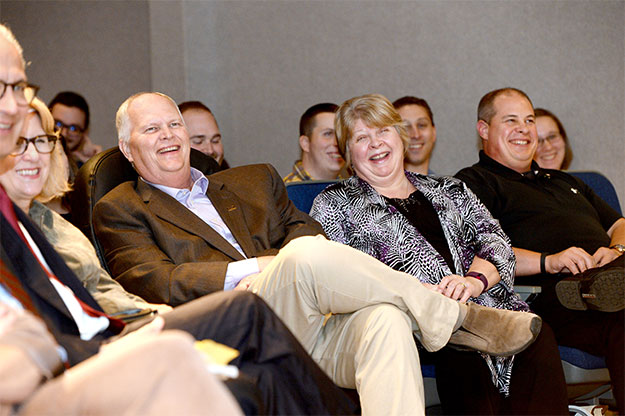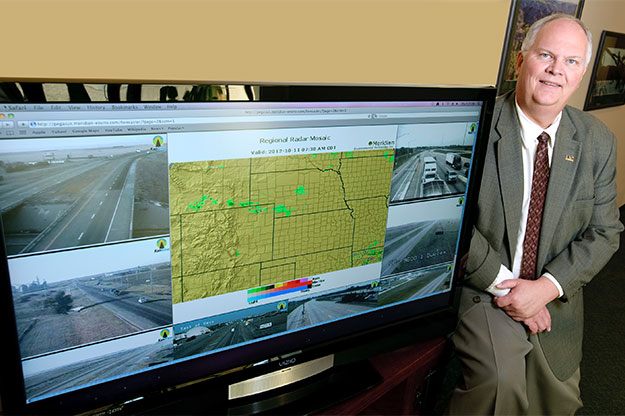Leon’s legacy
UND Chester Fritz Distinguished Professor Leon Osborne remembered as passionate weather pioneer

A single vase of flowers stood before the doors of UND’s Regional Weather Information Center (RWIC) Wednesday morning. They served as a symbol of the vibrant legacy of the man who spent endless hours within the Odegard Hall facility’s walls – forecasting, teaching, and innovating.
Leon Osborne Jr., known in the Grand Forks community as the “People’s Weatherman,” died Tuesday, Oct. 24, after a yearlong battle with pancreatic cancer. He was 63.
“Leon was a visionary and a man of the highest integrity,” said Mike Poellot, chair of the UND Department of Atmospheric Sciences and longtime friend of Osborne’s. “He was man of family and strong faith. He was down-to-earth, but dreamed big and worked hard to see his dreams come true.”
“Leon was an amazingly talented atmospheric scientist. He was an even better person,” said Mark Askelson, UND professor of Atmospheric Sciences and interim executive director of the Research Institute for Autonomous Systems. He was a former student of Osborne’s at UND. “I personally owe him for many successes, as he helped me immensely in my career. It’s hard to convey just how much Leon has meant to UND.”
As news about Osborne’s death circulated campus, other friends and colleagues found ways to pay their own respects. UND Chester Fritz Distinguished Professor of Biology Bill Sheridan, at the opening of Wednesday’s Faculty Lecture event, recited Gerard Manley Hopkins’ “Heaven—Haven” in remembrance of Osborne, fellow Chester Fritz Professor.
The University celebrated Osborne’s life last October, soon after he received his cancer diagnosis. More than 100 people gathered to honor the far-reaching impact of the UND Chester Fritz Distinguished Professor of Atmospheric Sciences – on the University and beyond.
There, UND President Mark Kennedy told the crowd that Osborne represented UND’s drive to reach new frontiers.
“Leon always will be one of the star professors on this campus,” President Kennedy said.

Weather trailblazer
A Texas native with degrees in physics and meteorology, Osborne took his career north and found an academic home at UND in 1978.
He immediately worked side-by-side with Poellot to envision and build what is now UND’s Department of Atmospheric Sciences. He led significant research efforts with the Federal Aviation Administration, the Bureau of Reclamation and the Federal Highway Administration that helped grow the campus research environment.
“His early research efforts really helped sustain and grow the John D. Odegard School in its early days,” Poellot said.
A longtime director of UND’s RWIC – as well as a linchpin in its creation – Osborne was vital in helping to forecast the devastating 1997 Greater Grand Forks flood. He was known for urging the community to prepare long before any other organization was willing to make that call.
“His opinions were sought by many and were highly valued. He could see the big picture and put things into perspective,” Poellot said. “He provided key information to emergency managers on campus, within the city, and the surrounding region, and was also a point of information for our congressional delegation.”
Osborne joined others at UND in developing the Advanced Transportation Weather Information System in 1996, operating out of the RWIC in Odegard Hall. The system, leveraging new computer and forecasting technology, soon led Osborne’s team to craft what we now know as “511” – an access number that drivers can call for on-demand information on weather and road conditions.
To make 511 applicable to the public, Osborne and his wife, Kathy, enlisted colleagues to start up Meridian Environmental Technology, Inc. The company began with a contract with the State of Minnesota. Today, 511 is keeping travelers safe across the country.
Osborne’s work with the RWIC – and as a local TV meteorologist in the late 1980s and 1990s – also made him the go-to-guy for area farmers, who relied on his winter forecasts and spring moisture predictions. Osborne would travel up and down the valley and across the region to personally share information and answer questions from agriculture producers and officials.
“When Leon had the floor, everyone stopped what they were doing and listened to what he had to say,” said UND Aerospace Dean Paul Lindseth at last October’s tribute event. “These farmers made decisions based on Leon’s forecasts as to what crops they would grow.”

Next generation
At his core, Osborne was a teacher. He was the director of both the undergraduate and graduate atmospheric sciences programs, and his experience with TV weather jump-started a student broadcast meteorology program, which Associate Professor Fred Remer now leads.
Remer says students will remember Osborne for his Texas panhandle habits – including a signature soft accent – but the memories will run deeper than that.
“It is amazing the number of alumni and former students that have reached out to the department and to his family over the past year to offer thanks for the motivation, inspiration and education that Leon provided them,” Remer said.
“Leon had charisma,” Askelson added. “He was a tremendous orator who made you want to hear what was coming next. He was compelling and passionate, and that passion carried through to his students.”
Last fall, Osborne’s friends and colleagues established a scholarship endowment in his honor called the Leon F. Osborne Science and Society Award. Recipients of the award will demonstrate an understanding of the societal importance of atmospheric science, and plan to pursue a career that addresses global issues through enhanced atmospheric science applications.
The scholarship will benefit UND’s leaders in action, a style of leadership Osborne modeled perfectly.
“One of the things he would ask every student — whether that was an undergraduate doing research for a senior project presentation, or a graduate student defending their thesis or dissertation – he always asked them, ‘What’s the value of your work to society?’” Poellot remembered. “That was always at the forefront for him.”
Services:
Funeral services: 2 p.m. Saturday, Oct. 28, 2017 at Sharon Lutheran Church, Grand Forks, N.D.
Visitation: 5 to 7 p.m. Friday, Oct. 27 with a 7 p.m. prayer service at Amundson Funeral Home. Visitation will continue the hour prior to the funeral in the church.
Internment: Calvary South Cemetery, Grand Forks, N.D.


